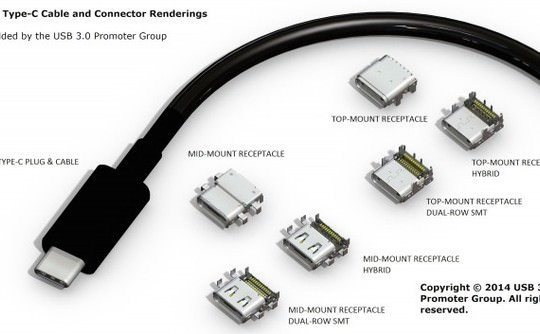Specifications USB 3.1 and connector USB Type-C can be implemented in many different ways, with the risk of creating confusion in the public.
He is having made an appearance in preview on Apple MacBook laptop, the reversible connector USB Type-C will begin in the coming months to spread on PCs, peripherals and mobile devices. A reversible connector is something that the industry is waiting for since the introduction of the first generation of USB in 1997, it should be noted that not all implementations will support necessarily all of the features introduced by the latest version of the USB specification and that there may be almost a dozen variations of USB-C with different functionality.
The USB 3.1 specification introduced the reversible connector Type-C to 24-pin and many other features that while expanding the opportunities for use of the USB bus, maintain backward compatibility with previous versions of the standard. With the ultimate aim of creating an interconnection that can do almost everything, has been increased given signaling rate 10Gb / s, USB 3.1 so that an implementation state of the art should be capable of a peak bandwidth of about 1.2 GB/s. USB 3.1 supports also 2.0 specifications for the supply of current, allowing to transfer up to 100W of power on a single cable.
The USB connector Type-C and USB 3.1 specifications also allow vendors to implement proprietary features thanks to Alternate Mode and Accessory to differentiate their products. The problem is that not all features are mandatory for implementation.
What happens in practice? The connectors USB Type-C may be used with any USB controller 2.0, 3.0, 3.1 or Thunderbolt 3, which enables different manufacturers to build new devices without having to use the USB 3.1 controller, expensive and wasteful from the point of view of energy.
The downside is that different devices will have the same physical connector but support different data-transfer speed (480 MB/s, 5 GB/s or 10 GB/s). The differences do not stop here: the various hardware manufacturers have the possibility to choose whether or not to integrate the functionality to support DisplayPort via USB-C, which means that some devices, there will also be an output for display on that other devices, even with the same connector, will not be present. Finally also the USB Power Delivery technology will be integrated to the manufacturer’s choice.
In this sea of combinations the only lighthouse is represented by eight specific labels that the USB Implementers Forum designed to describe the functionality of the USB-C. In contrast, it should be noted that the presence of a connector USB 3.1 Type-C offers no immediate indication on its functionality.
Currently the only implementation of the connector USB 3.1 Type-C can support entirely all the features of the standard can be performed using the controller Alpine Ridge from Intel, which also supports Thunderbolt 3 to 40GB s. To date the only manufacturer to use Alpine Ridge is Gigabyte, on motherboards based on Intel Z170.
Besides the various connectors, it will also be the proliferation of many different cables and numerous adapters that will allow new devices to connect to older systems and older devices to connect to the latest systems.
The various implementations of USB Type-C will enable manufacturers to incorporate the technology into their products also will not cost and will speed up the dissemination of the new connector. This approach will a great confusion in the market, with the risk that a slice of the public is not able to fully appreciate the capabilities of USB 3.1 thus underestimating the potential.



